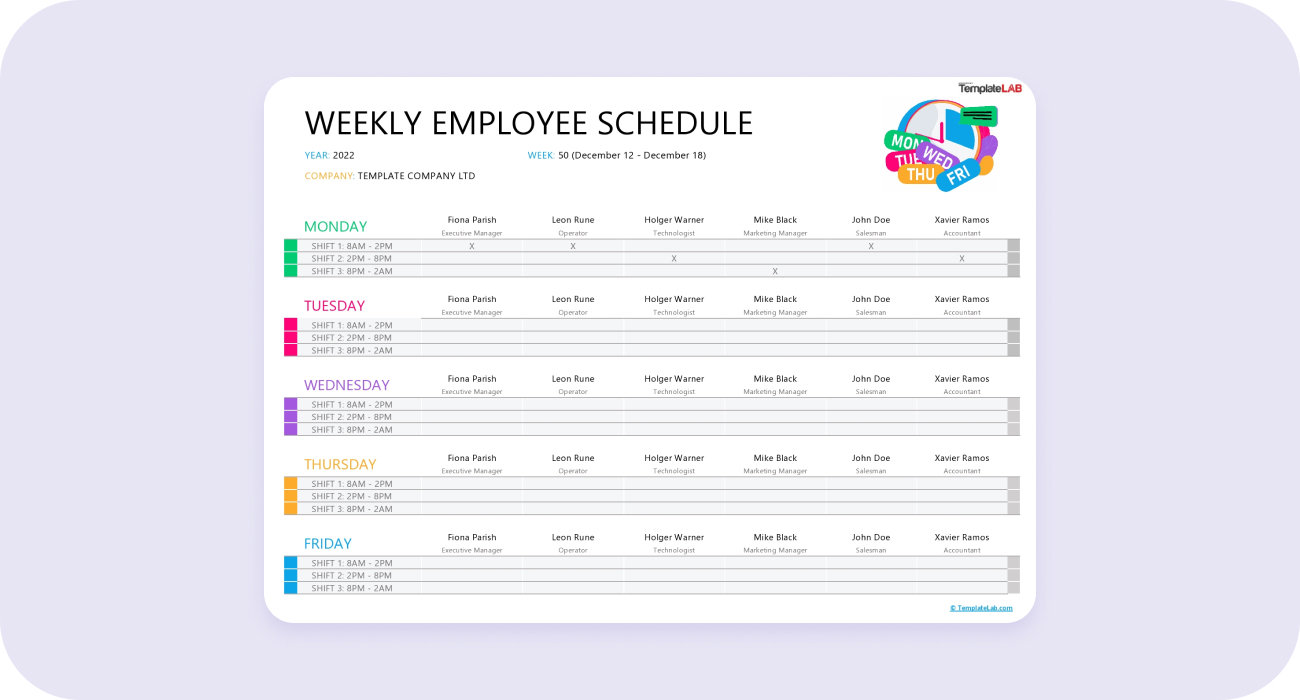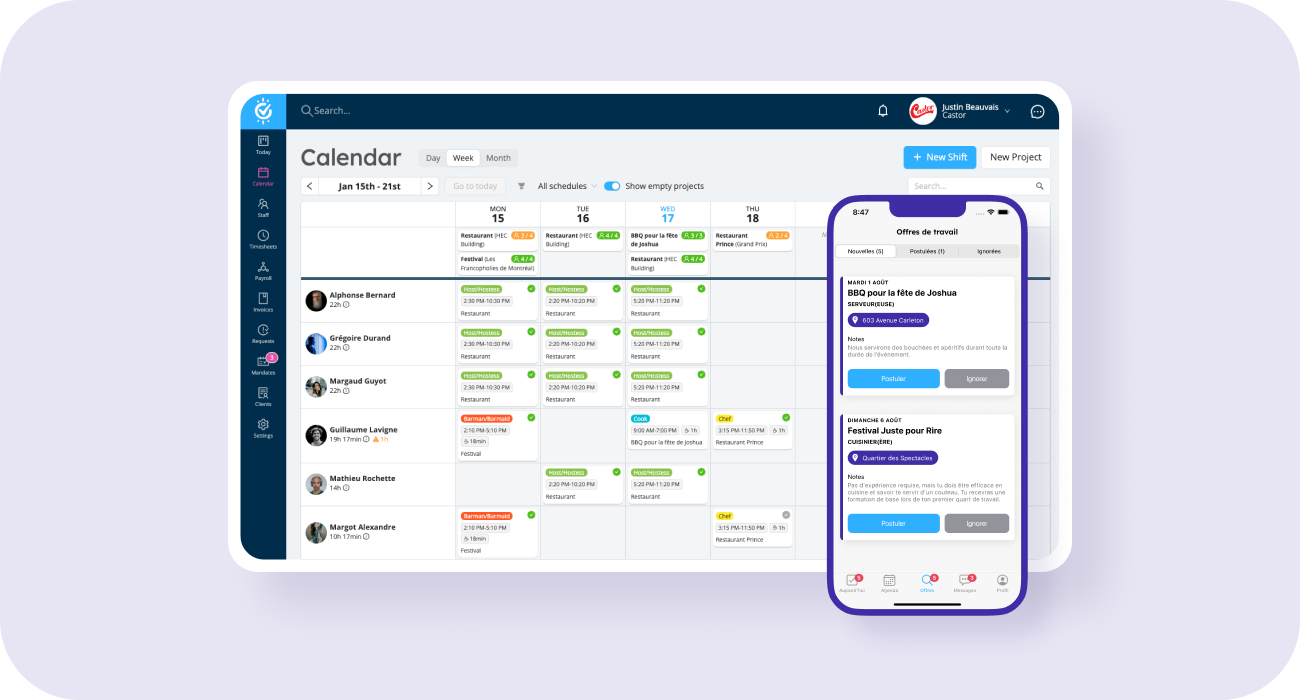It's as simple as this: scheduling can make or break your entire staff.
Strategic scheduling is the linchpin for the success of your team, an often underestimated factor in fostering employee well-being and productivity.
While compensation and organizational culture are commonly acknowledged pillars of employee welfare, work schedules can often go unrecognized.
In today's corporate world, the area of workforce management demands a big-time shift towards enhanced automation and optimization, as companies grapple with the inadequacies of traditional staff scheduling and planning methods.
To begin with, staff scheduling dealt with unprecedented challenges amid the disruptions of the COVID-19 pandemic, and it remains an ongoing challenge for teams worldwide.
From the constraints of a limited labor supply to the implementation of hybrid work conditions and broader HR transformations, the complexities have forced businesses to undertake a more nuanced approach to staff scheduling.
A well-crafted scheduling system can significantly influence the well-being of your employees, yielding downstream benefits such as improved sleep, economic stability, and overall happiness. Failing to consider all variables in staff scheduling can result in substantial declines in productivity. From issues like tardiness to higher turnover rates, identifying the root cause of inefficiencies in your scheduling process can prove elusive.
The art and science of staff scheduling require a mastery of the myriad variables at play. Human Resources and People teams that adeptly navigate these complexities will not only elevate the efficiency of staff scheduling but also the overall success and satisfaction of their workforce.

What is Staff Scheduling?
Effective staff scheduling is a critical component of workforce management, ensuring that you’re able to optimally deploy human resources to meet operational requirements, all while maintaining employee satisfaction and productivity.
However, staff scheduling has become a delicate balancing act in 2024, involving not only full-time employees but also temporary and flexible members.
Traditionally, staff scheduling primarily focused on allocating regular full-time staff to shifts based on their availability and skills. However, the modern workforce is characterized by greater diversity, with an increasing reliance on temporary and flexible workers.
Staffing requirements often fluctuate, and businesses must adapt swiftly to seasonal demands, project-based work, or unexpected surges in activity. This calls for a purposeful tactic towards staff scheduling that takes into the unique challenges posed by your temporary and flexible members.
One key aspect of managing temporary and flexible staff is aligning their schedules with your particular organizational needs. This involves creating a flexible framework that accommodates the ebb and flow of work demands. Leveraging technology —such as staff scheduling software— can help in automating these processes, considering factors like employee preferences, skills, and compliance with labor regulations.
Moreover, effective staff scheduling goes beyond mere task assignment. It includes considerations for employee well-being, balancing workloads, and fostering a positive work environment. You will need to strike a balance between meeting operational requirements and acknowledging the diverse needs of your workforce.
By embracing a comprehensive approach to staff scheduling, your business can enhance its adaptability, responsiveness, and overall efficiency. This includes integrating real-time data, predictive analytics, and employee feedback to refine scheduling practices continually. In doing so, you can not only meet short-term objectives but also cultivate a resilient and engaged workforce that contributes to long-term success.

Why is Staff Scheduling Important?
Effective staff scheduling is the beating heart of any successful team, holding the power to either elevate collaboration and productivity or cast a shadow over collective morale.
The nuances of scheduling stretch beyond mere hour assignments; they involve maintaining a delicate balance between individual well-being and the collaborative synergy within the team.
Carefully planned schedules reflect an organization's dedication to its employees, acknowledging their strengths, limitations, and the importance of a balanced work-life harmony. A well-crafted schedule resonates within a team, fostering unity and a shared sense of purpose.
On the other hand, if you’re a little haphazard or inconsiderate when it comes to scheduling, you risk fracturing this harmony and inviting burnout, diminished job satisfaction, and a decline in overall team efficacy.
Thus, the profound impact of scheduling on a team's dynamics underscores the ethical responsibility leaders bear in cultivating an environment that values both professional contributions and personal well-being. All in all, staff scheduling is a compassionate practice; it’s knit deeply into the fabric of your team's success, with the potential to either nurture a flourishing ecosystem or sow the seeds of discord.
Here are specific reasons highlighting the importance of effective staff scheduling for your workforce.
Workforce Efficiency
Research by the Society for Human Resource Management (SHRM) shows organizations with optimized workforce scheduling experience a 20% increase in productivity.
Effective staff scheduling ensures that the right number of employees with the appropriate skills are available at any given time. For security firms, that means making sure each entrance, patrol route and control-room shift is staffed by properly trained guards. Adopting security company scheduling software helps you build these rotas in minutes, quickly move people between posts when something changes, and see coverage across all sites at a glance. By aligning staffing levels with workload demands, you can minimize overtime, avoid understaffing and keep both clients and guards satisfied. For security firms, that means making sure each entrance, patrol route and control-room shift is staffed by properly trained guards.
This means you also get to minimize downtime, maximize productivity, and still verify tasks are completed efficiently. By aligning staffing levels with workload demands, you can avoid overstaffing or understaffing issues that almost always result in decreased efficiency and increased costs.
Employee Satisfaction
Balanced and fair staff schedules contribute to employee satisfaction and well-being.
Predictable work hours and reasonable workload distribution help employees achieve a healthy work-life balance. This fosters a positive workplace culture, boosts morale, and reduces burnout, all while enhancing retention rates and maintaining a motivated workforce.
Cost Control
Proper staff scheduling helps in controlling labor costs by matching your staffing levels with operational standards. Not only does it help you avoid unnecessary overtime expenses and reduce labor waste during slow periods but it also enables you to adhere to budget constraints.
It’s your best bet at allocating resources more efficiently to improve financial stability, not to mention enable better planning for future investments and growth.
Personalized Customer Service
A well-thought-out staff schedule guarantees that you have the right personnel available during peak customer demand periods. Of course, this paves the way for improved and personalized customer experiences, as employees are adequately trained and equipped to handle high volumes of inquiries, orders, or service requests. Satisfied customers contribute to repeat business and positive word-of-mouth, which is crucial for sustaining and expanding a customer base.
Compliance
Effective staff scheduling helps you comply with regulations regarding working hours, breaks, and overtime. This not only mitigates legal risks but also demonstrates a commitment to ethical and lawful business practices, fostering a positive reputation in the eyes of both employees and regulatory authorities. Compliance establishes a harmonious relationship between the organization and its workforce, reducing the likelihood of disputes and legal challenges.

How Do You Develop a Staff Schedule?
It’s neither straightforward nor smooth sailing to create a staff schedule - as simple as it may appear initially.
You will need to meticulously consider various elements that profoundly impact both your organization and your workforce. Aligning with individual preferences and ensuring a balanced work-life equation is a tall order. Beyond this, accommodating diverse skill sets, necessary certifications, and stringent compliance rules only makes the situation more convoluted.
After all, management is a skill; it entails significant practice and effort. It involves grasping both the broader perspective, such as nurturing a positive, supportive work atmosphere, and the daily details, like ensuring meticulous attention to scheduling.
Fortunately, advancements in technology have substantially streamlined the entire process. While juggling many moving parts, here are some useful starting points to kick off effective staff scheduling:
Prioritize Employee Availability
This may seem like a no-brainer, but an effective employee schedule must focus on employee availability. Availability is the end-all and be-all in many cases.
Managers need to be considering their staff's schedules rather than imposing rigid ones. This approach not only streamlines the scheduling process but also minimizes the need for frequent adjustments. Without this consideration, constant modifications may become necessary to align the schedule with employees' availability, leading to potential disruptions.
Easy to Read and Share
A well-crafted employee schedule leaves room for simplicity. It should be easily comprehensible and shareable among team members.
Once the employee schedule is created, it's essential to ascertain its accuracy by thoroughly proofreading it. This precautionary measure prevents confusion regarding time slots and employee names, saving you from potential complications.
Keep the Local Laws in Mind
A quality employee schedule adheres to local laws and regulations governing labor practices. Given the variations in labor laws across states and countries, it's crucial to confirm that your schedule complies with legal standards. Failure to do so may result in significant fines.
Fits Business Needs
To create an employee schedule, start by gaining a comprehensive understanding of your business. Deepen your knowledge of your organization's workflow, task durations, and peak operational hours. And then, you can tailor the schedule based on these insights and consider whether your workforce predominantly comprises part-time or full-time employees.
For example, in a restaurant setting, scheduling during peak hours requires a focus on full-time workers. Additionally, see to it that scheduled hours align with company policies and state scheduling laws.
Know Your Employees
Building an effective schedule involves understanding both your team's needs and your business requirements. To strike a balance that satisfies both parties, assess your team's skills, work preferences, and ideal working hours. Consider factors like morning or evening preferences, planned vacations, overtime restrictions, strengths, weaknesses, preferred days off, and full-time or part-time preferences.
Identify employees willing to work extra shifts rather than assigning additional hours to unwilling staff. This approach lays the groundwork for a more cooperative and productive work environment.
Deliver easy access to the employee schedule, whether your organization operates remotely or on-site. Providing online access avoids the hassle of daily calls or inquiries, allowing employees to check their schedules conveniently. Utilize platforms like Excel or scheduling software to share schedules, and notify employees promptly of any changes.
You also need to be detecting and identifying schedule abuse as and when it happens. Be vigilant for signs such as constant schedule change requests, frequent early departures, and consistent requests for substitutes. Once you’ve addressed issues promptly, consider the possibility of personal challenges affecting employees.
Communicate Effectively
Effective communication is crucial for the success of any employee scheduling system. Share the schedule during meetings, double-checking that your team understands it and its purpose. Provide ample notice of upcoming schedules, explaining any deviations and the benefits to the organization.
Get the Schedule Out Quickly
To accommodate your employees' commitments and plans, release the employee schedule well in advance. This allows your team to plan, reschedule personal commitments, find substitutes, and communicate any needed adjustments promptly.
Keep the Schedule Flexible
Flexibility is the name of the game in employee scheduling, especially in multi-location scenarios. Instead of imposing schedules, provide employees with the freedom to request adjustments. If a reliable employee is struggling with the schedule, consider making changes to accommodate their needs.

Staff Scheduling Templates
Many HR teams prefer the use of set templates for organizing staff scheduling to maintain a structured and clean system.
Here are some templates you may want to consider leveraging while planning your schedules:
With that said, despite the abundance of resources available online, the reliance on templates and spreadsheets comes with its challenges.
The time-consuming nature of rekeying and manipulating data, along with the difficulty in performing accurate staffing tradeoff analysis, presents a drawback. Complex work rules, staff preferences, and the inability to easily explore alternatives also contribute to the inefficiency of these methods. Over-staffing and under-staffing issues can arise, leading to compromised schedules that may not align properly with call demand. To address these challenges, more automation solutions such as staff scheduling apps are recommended as they can centralize information in a single location with real-time tracking.

What are the Best Practices in Staff Scheduling?
As tricky of a dance as it is to customize schedules to suit your workforce’s particular needs, there are certain best practices you can undertake to facilitate a more flexible scheduling process. Bear in mind that there's no one-size-fits-all solution, and you’ll have to embrace an iterative process with elements of trial and error. Patience and a willingness to learn from experience are essential, as is making adjustments to strategies as needed. In the end, as long as you’re embracing flexibility, staying attuned to team needs, and using adaptable scheduling approaches, scheduling can indeed become the strength and fuel that empowers your organization rather than the shackles that constrain it.
Here are some general best practices that can optimize your staff scheduling method:
Comprehensive Time Tracking
Record all employee work hours thoroughly to gain insights into cash flow, overtime expenditures, and potential understaffing issues. This pristine time data acts as a crucial audit trail, especially in the event of labor disputes, providing a transparent record of activities.
Simplify the Process With Automation
Opt for user-friendly systems that are easy for both employees and managers to navigate. Complexity often leads to misuse or non-compliance. The automation of the recording of essential details like department and position assures efficiency and reduces the likelihood of errors.
Choose suitable clocking methods, including touchless options to prioritize employee safety and prevent contamination. Implement staggered clock-in times and arrange physical spaces to facilitate social distancing. For remote workers, offer accessible mobile or web-based alternatives to invite seamless participation in the time-tracking process.
Vigilance & Accuracy
Streamline the process for employees to clock out for breaks, preventing them from clocking back in too early. Utilize the time-tracking system to document compliance with break laws, promoting a structured approach to rest periods and preventing potential legal issues.
If possible, try to implement geofencing to verify in real-time that employees are clocking in at the correct location and within the specified time frames. This also includes monitoring employee work hours diligently to identify patterns of excessive overtime, late clock-ins, early departures, and other mistakes. This way, you can detect errors early and proceed with correction of behaviors and effective planning to minimize the impact on both cash flow and project milestones.
At the end of the day, your software needs to guarantee that the time records align with actual work locations, reducing the risk of unauthorized clock-ins or fraudulent time entries.
Consider Employee Input
Employee engagement and satisfaction should sit at the heart of your scheduling structure.
By actively seeking input from employees regarding their preferred schedules and considering individual constraints, you can foster a sense of empowerment and inclusivity and encourage a healthy work-life balance. Prioritizing employee well-being through thoughtful scheduling practices, such as avoiding excessive overtime and strategically planning breaks, helps prevent burnout and enhances overall job satisfaction. Offering flexible scheduling options, like compressed workweeks or remote work also demonstrates care and consideration for your employees.
Finally, transparent communication about scheduling decisions and providing schedules well in advance allows employees to plan their personal lives. Everyone wants to operate in a positive work environment, after all.
Your staff also becomes actively bolstered by having some control over their schedules, whether through self-service portals or interactive scheduling tools.
Try A Scheduling Software
Many in the industry have reported using advanced scheduling software to manage employee schedules and work hours.
By instantly broadcasting shifts to the entire staff or a select few, the software can substantially streamline the process of finding available and qualified personnel. This facilitates quick responses from interested candidates, and the software efficiently organizes and tracks applicants as they apply to shifts. The system's capability to confirm schedules upon booking ensures a seamless and transparent scheduling process. Additionally, the integration of an automated time clock enhances on-site management, sending reminders to your employees to clock in and out through geo-tagging or QR code-based systems.
With a real-time tracking feature, you can immediately identify shift-swapping needs or replacements. These software apps don't stop working after shifts end, either; they continue by ensuring accurate timesheets are submitted and approved. Such platforms even support contractors in creating and submitting invoices based on approved hours, contributing to a comprehensive and automated workforce management solution.
One of the tools you can consider is Workstaff’s on-demand shift scheduling software, through which you can promptly broadcast shifts to your entire staff or handpick individuals based on your needs.

What Are the Challenges With Staff Scheduling?
Staff scheduling has always been a tough nut to crack.
Unlike planning, scheduling involves the coordination of numerous independent jobs, determining when each task will be executed, and assigning responsibilities to specific individuals. One of the primary difficulties lies in the vast array of information required for effective scheduling. You must have a comprehensive understanding of work orders, their relative importance, scope, and current status, along with the operating schedule, workforce availability, and the skills and limitations of each employee. There is often the matter of dynamic work that fluctuates based on the scope of the role - which only further complicates the scheduling process.
You also have to think about the perception of the schedule by your workforce. Concerns about how the schedule will be received by those tasked with the work can create obstacles. Encouraging and incorporating the input of employees is crucial to addressing this concern. Additionally, introducing new scheduling systems requires clear communication regarding the purpose of the schedule—providing better service to operating customers by allowing confident scheduling of operations and increasing overall work efficiency.
At a glance, these are some of the most pressing challenges around staff scheduling:
Shift Preferences and Availability: Juggling the diverse shift preferences and limited availability of employees poses a mammoth challenge, impacting the creation of a balanced and efficient schedule.
Overtime Management: Striking the right balance between meeting staffing requirements and avoiding excessive overtime costs is crucial for financial sustainability and employee well-being.
Last-Minute Changes and Adaptability: Dealing with unexpected events, such as sudden call-offs or changes in demand, requires a high degree of adaptability and quick adjustments to the schedule that many companies cannot muster in time.
Compliance with Labor Laws: Making sure that staff schedules adhere to labor regulations, including working hours, breaks, and rest periods, is essential to avoid legal issues and promote a healthy work environment.
Communication and Coordination: Establishing effective communication channels and coordination mechanisms among staff members is vital for keeping everyone informed about schedule changes and updates.
Technology Implementation and Training: Successfully implementing and managing scheduling software or systems requires overcoming challenges related to staff training, adaptation, and potential resistance to new technologies.

Signs You Need Staff Scheduling Support
Poor scheduling may not be immediately obvious as an issue but leave no doubt that it lurks beneath the surface of every operation, process, and employee's daily experience.
It subtly infiltrates productivity, output, and overall work satisfaction, eventually making its presence felt in the customer experience. That’s why you have to proactively investigate and pinpoint where and how it is doing the most damage. Identifying these subtle indicators is the first step for businesses to comprehend the full extent of the issue. Only through a vigilant assessment can you determine when and where to initiate mitigation strategies, making sure that the detrimental effects of poor scheduling are addressed before they escalate into more significant challenges.
Nevertheless, these are some glaring signs that your organization might need staff scheduling support and improvements:
Employee Burnout and Fatigue
If your staff is consistently exhausted and burnt out, something might be amiss with your scheduling.
Overworked employees experience a decline in performance, increased errors, and even a higher likelihood of accidents. Just imagine a fatigued nurse administers the wrong medication dosage due to a scheduling mishap, leading to a potentially life-threatening situation for a patient. Or think about overburdened retail associates who struggle to manage long checkout lines and assist customers effectively.
The outcome of staff burnout is not just a dip in productivity but can have severe consequences on the well-being of both your employees and those they serve.
Increased Turnover Rates
If you're observing a revolving door of employees or struggling to retain talented staff, scheduling issues may provide some answers. Employees under inconsistent scheduling are frequently leaving positions, especially if their work hours conflict with personal affairs. To add to the frustration, the remaining staff may grapple with the challenges of adapting to frequent personnel changes, further perpetuating a cycle of turnover that can erode the overall effectiveness and reputation of the company.
Customer Service Decline
A sure sign that you need staff scheduling support is a decline in customer service quality. For example, going back to a retail environment: if there are too few employees during peak hours, resulting in long queues and frustrated customers, you will instantly see the cascading effect in the form of negative online reviews and complaints from dissatisfied patrons.
Inadequate scheduling not only affects the workload of your staff but directly influences the customer experience, potentially leading to lost business and a damaged reputation.
Inefficient Use of Resources
When your scheduling process is not optimized, it can lead to wasteful use of resources.
The tangible effects of inefficiencies in resource allocation become apparent when time-sensitive projects experience delays, causing the accumulation of costs associated with idle equipment. This not only leads to a direct financial shortfall but also undermines your competitive position and capacity to meet customer demands promptly. You have no choice but to connect the dots between scheduling organizational growth and sustainability.
Compliance Risks and Legal Issues
In industries with strict regulations, improper staff scheduling can expose your organization to compliance risks and legal issues. For example, in the healthcare sector, a scheduling error that results in inadequate staffing levels during a regulatory inspection could lead to hefty fines, reputational damage, and potential legal action, all of which can unfold rapidly within a matter of a week, leaving you scrambling for solutions.
Effective staff scheduling support not only reinforces compliance with regulations but also protects your organization from the financial and legal ramifications of non-compliance.

Why Use Staff Scheduling Software?
Hiring managers often face the need to optimize their workforce, either by leveraging existing employees more efficiently or tapping into new sources such as part-time workers or contingent labor.
The answer to managing this complexity at scale lies in intelligent employee scheduling software, which provides a holistic view of your workforce operations. These modern automation solutions enable data-driven decision-making, leading to improved scheduling efficiency, increased operational agility, heightened productivity, and enhanced employee job satisfaction.
You can consolidate all necessary information in one convenient place, facilitating quick communication with employees through direct messages. The simplicity and user-friendliness of this software make scheduling a breeze, providing hiring managers with a tool to create the perfect schedule in minutes.
With the ability to streamline complex scheduling tasks, optimize workforce allocation, and adapt swiftly to evolving demands, staff scheduling software emerges as the indomitable cornerstone for businesses aspiring not only to stack up against their competitors but surpass them in the relentless pursuit of operational excellence.
Smart Scheduling
Software with Smart Scheduling allows you to craft comprehensive schedules effortlessly, considering location, positions, and remuneration. In addition to the flexibility of easy shift editing and time-saving repeats, you can utilize a centralized hub that seamlessly associates specific managers with clients and projects. You can even accelerate shift filling with "First Come, First Served and Urgent Offers" through advanced publishing and automatic options.
Calendar Views
Software with calendar functionality enables you to monitor all your schedules and track your staffing progress at a glance. Easily differentiate between complete and incomplete projects while effortlessly keeping track of all your projects and bookings. You can also keep an eye on your staff's planned time and availability, ensuring a clear understanding of their schedules.
Time & Attendance Tracking
An effective staff scheduling software provides access to a mobile app for both iOS and Android, confirming accurate time and attendance tracking. Make sure it includes a built-in clock-in/clock-out feature that allows your staff to conveniently log their hours directly from the mobile app, complete with rounding rules and automatic adjustments.
Automatic reminders, signalled by timely push notifications, that your staff remembers to clock in before their shifts and receive prompts when they forget. You can also store attendance records through geo-tagged or QR code-based clock-ins, providing a secure method for attendance verification. With live presence reporting, you can stay informed about who's on the job, whether they clocked in or out, late or early, ensuring real-time visibility into your team's activities.
Employee Messaging System
Staff scheduling software also includes features to help you stay connected with your team at all times. Say goodbye to the tedious task of managing emails, text messages, phone calls, and social media platforms. Instead, build greater connections with a centralized hub and messaging system that keeps your team accessible throughout the day.
Now, you can engage in team conversations, with members automatically added or removed as your team changes. You can also use broadcasts to send mass messages to all staff and leverage instant push notifications to keep your team up-to-date.
Flex & Temp Staff Management
Do you have a lot of temp staff that need to be integrated into the staff scheduling system? A scheduling software extends the convenience of easily publishing offers tailored to your staffing needs. You instantly know who's available to work by publishing shifts to your entire staff bank or a select few, depending on your requirements.
With Workstaff’s temp staff management and messaging app, you can quickly broadcast shifts to your staff, facilitating a swift process to gather interested candidates. Seamlessly organize applicants as they apply to shifts, streamlining the selection process. When you find the right fit, book them to confirm their schedules, ensuring efficient and effective shift management tailored to your specific requirements.
The app also facilitates hassle-free timesheet submission and approval, making payroll a breeze. This eliminates manual processing substantially as your system generates ready-to-use reports and exports. With integrated payroll functionality and automated checks, you can bid farewell to inconsistencies and missing data.

Approach Staff Scheduling With Confidence
The significance of staff scheduling extends far beyond mere time management; it is the cornerstone of a thriving and scalable workplace that can go places.
By investing in an efficient employee scheduling system, you can navigate the complexities of workforce management with confidence, compassion, and strategic vision. From financial stability through precise cash flow insights to accurate attendance tracking for seamless payroll processing, and from ensuring adequate staffing for optimal customer service to fostering fair treatment of staff through transparent leave allocation, a robust scheduling solution propels a business toward excellence and unprecedented growth.
Moreover, you can build an environment for employees that allows them freedom, balance, and empowerment to make a difference. As we delve deeper into the digital era, and a myriad of sophisticated applications enter the marketplace, you must embrace employee scheduling as a fundamental tool. Not only do you get to enhance operational efficiency, but you also get to create a professional setting wherein the well-being of both the business and its invaluable staff is prioritized. It's not just about managing time; it's about cultivating productivity, fairness, and prosperity for the collective journey ahead.
If a staff scheduling app is on your radar, or you’d just like more automation to tackle the complex task of organizing shift schedules, consider the Workstaff Shift Scheduling platform. It enables you to put together your team at lightning speed whenever you need them, saving you hours along the way and bringing you some well-deserved peace of mind. It also makes it a piece of cake to instantly know who’s available and interested in working as you can simply publish shifts to your entire staff bank.
Additionally, you’re able to effortlessly consolidate your staff's earnings and receive comprehensive reports ready to be seamlessly integrated into your external payroll software. No more data errors, no more manual work, no more spreadsheets and inconsistencies - just staff scheduling automation at its most efficient.











